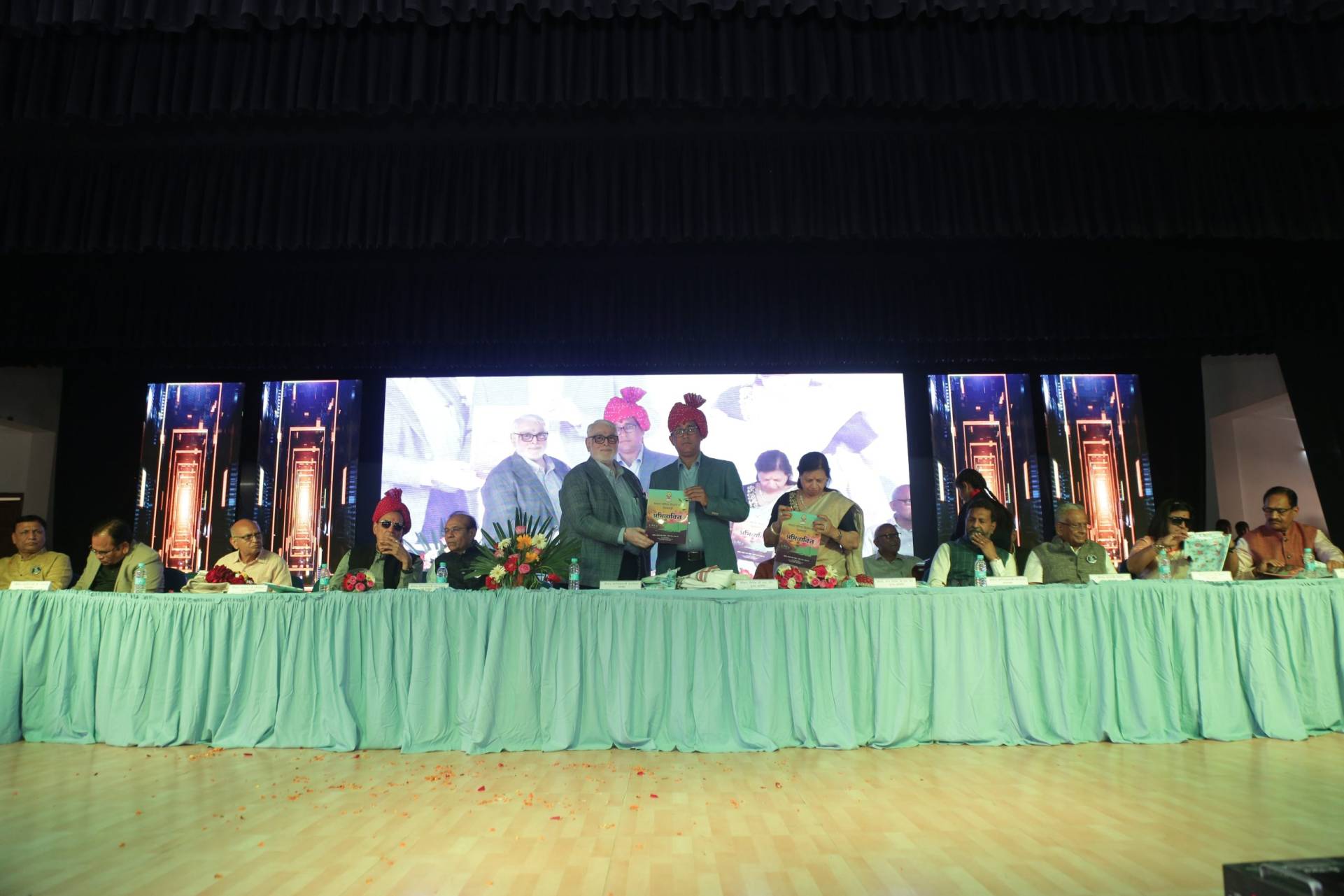
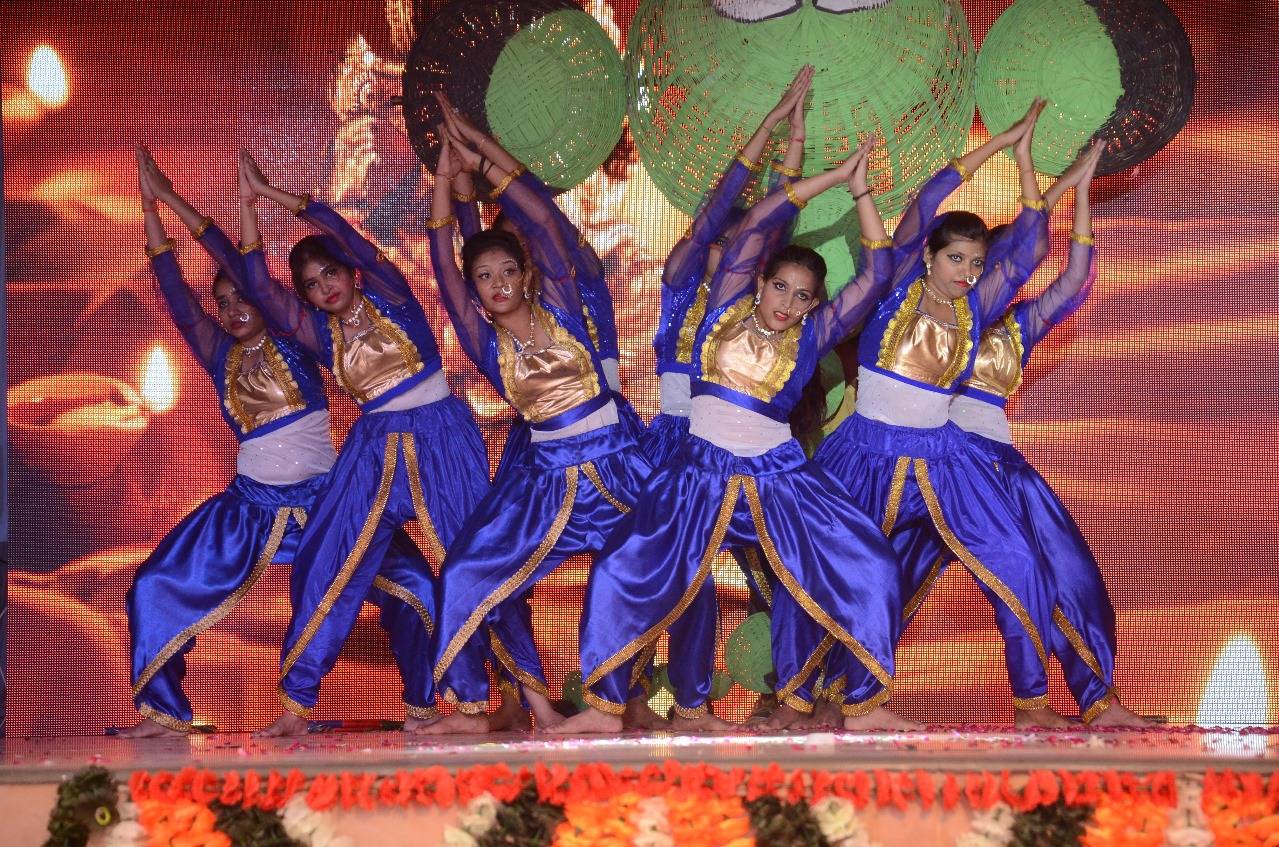
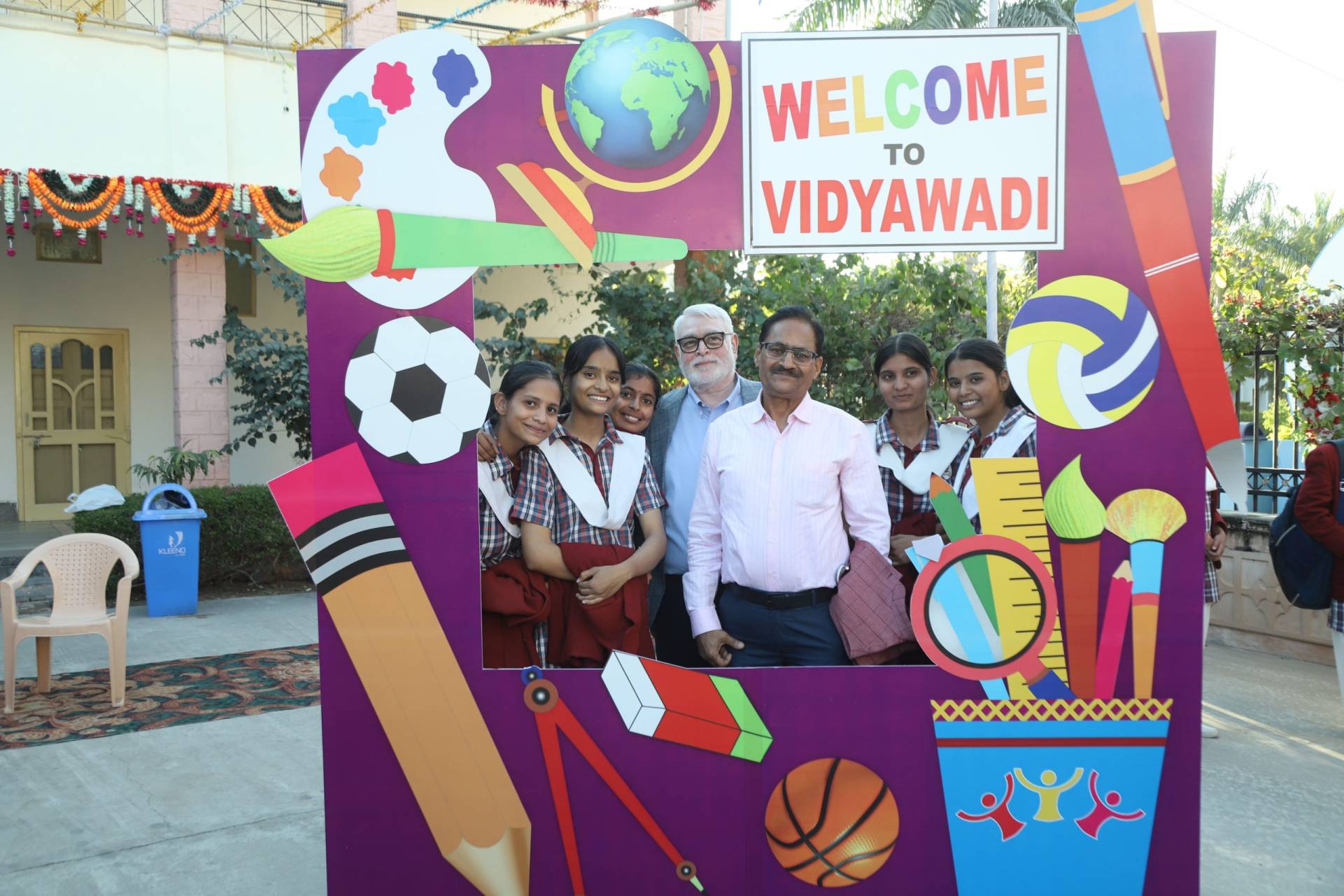
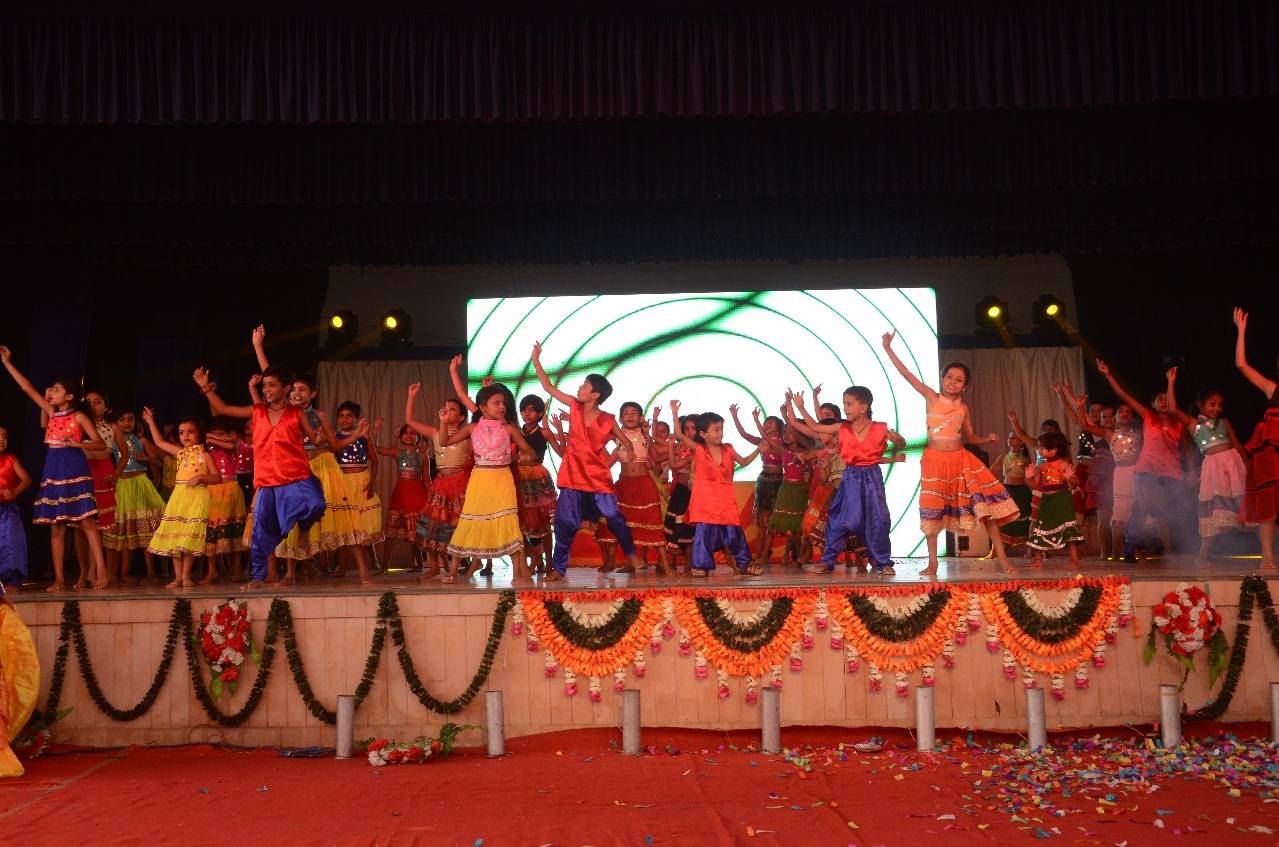

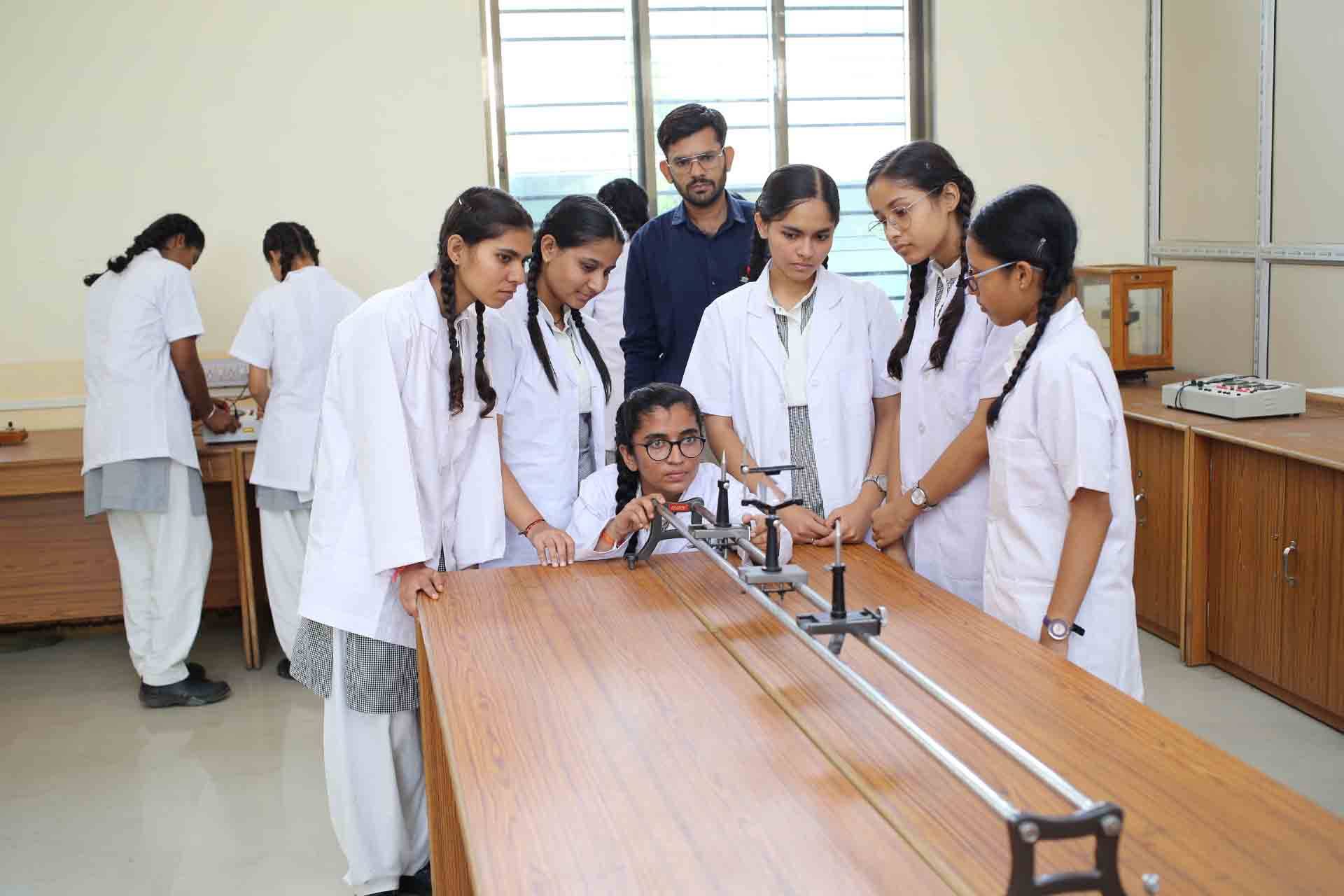
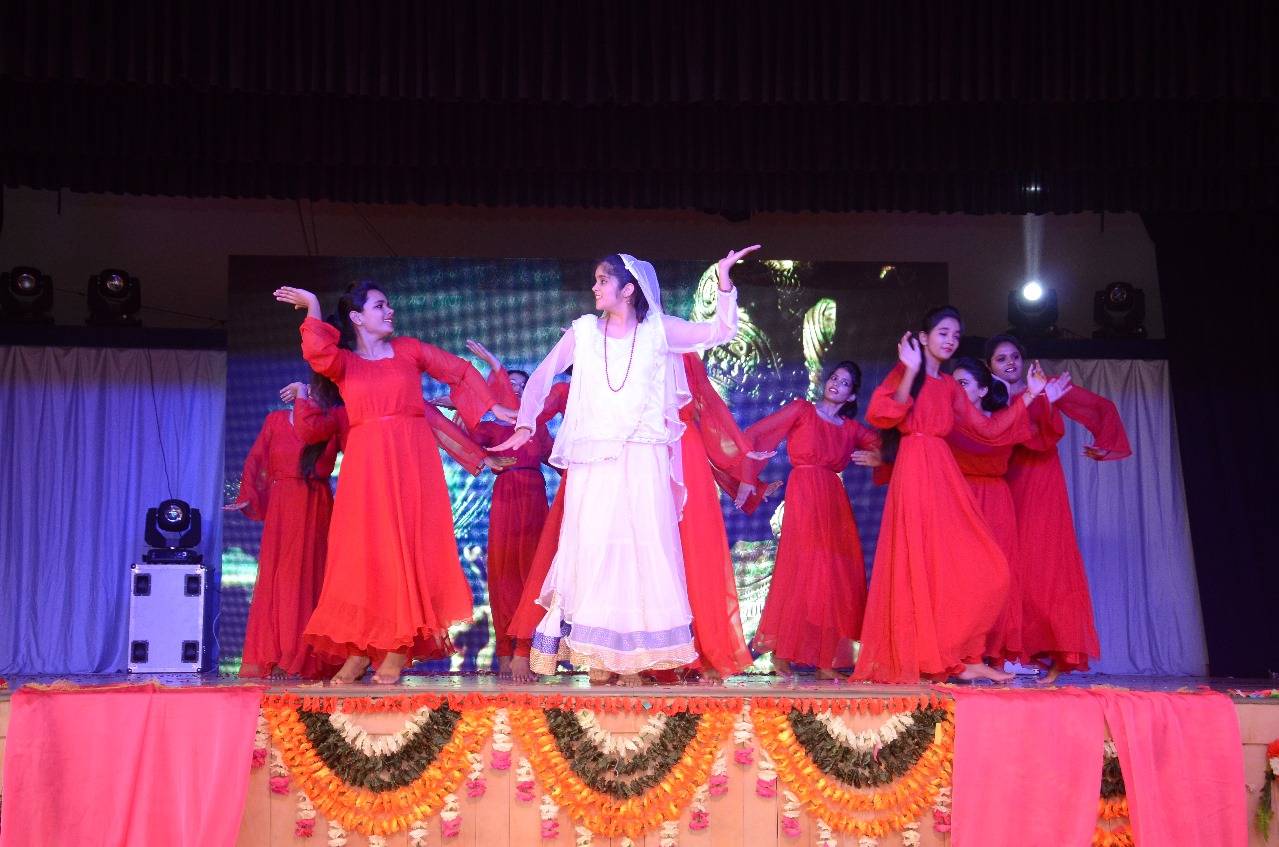
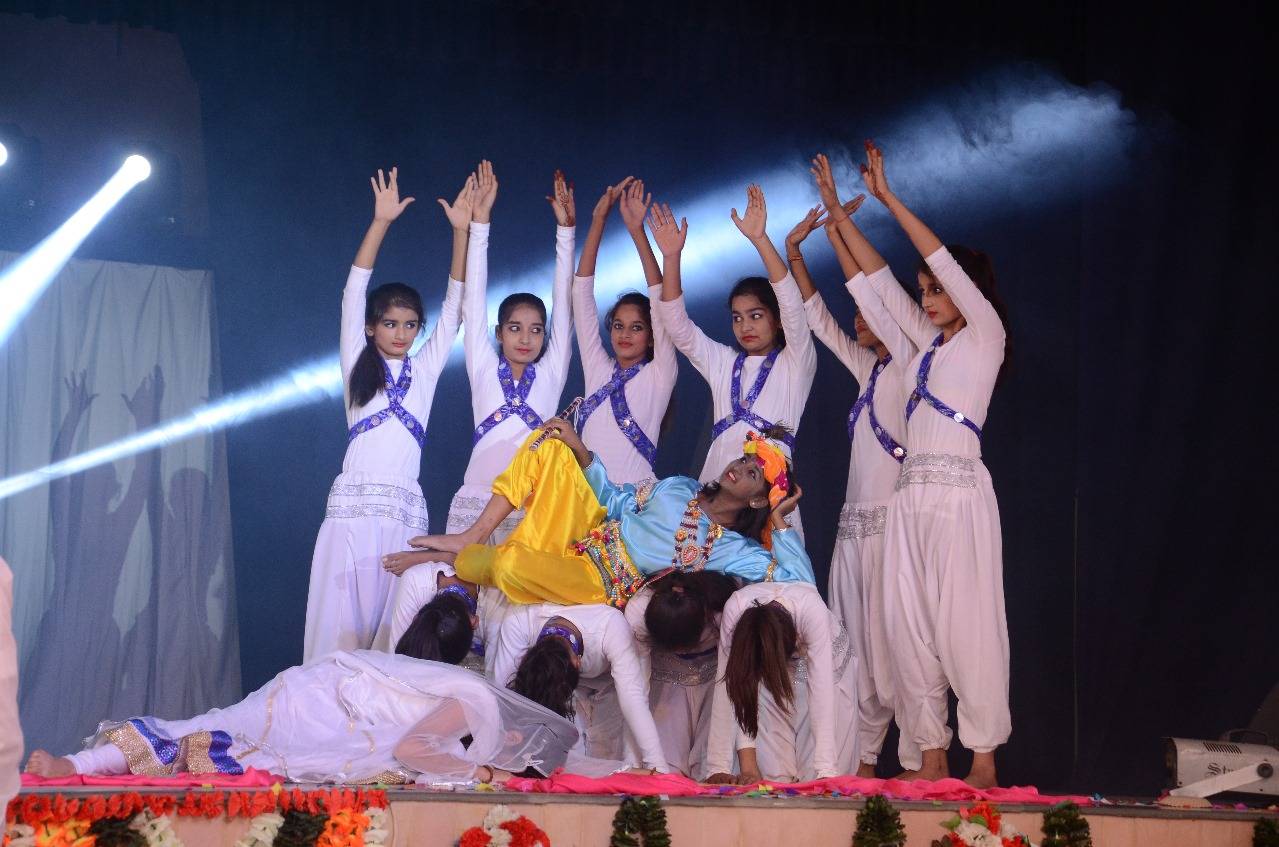

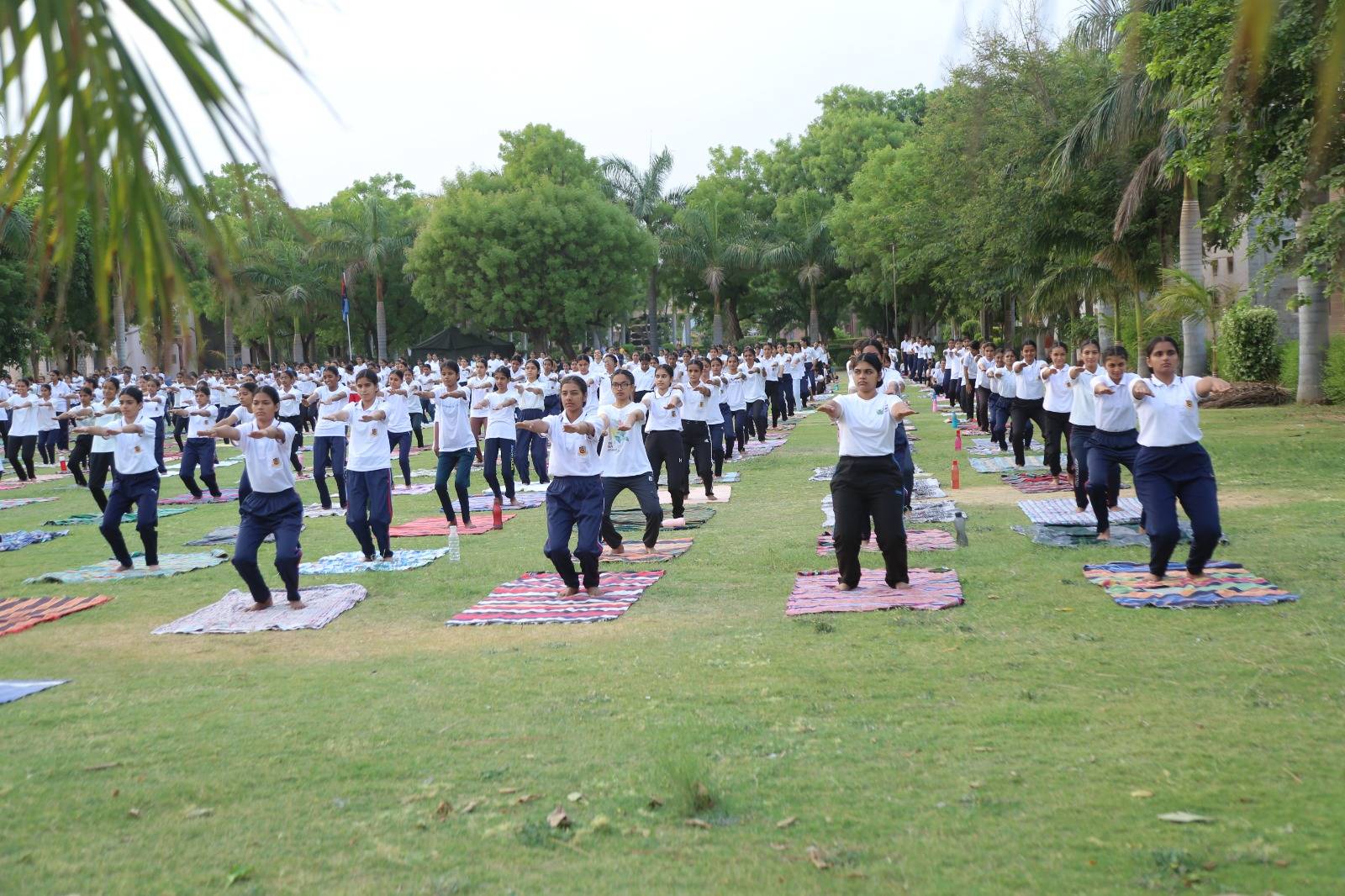
Sports: – The present-day education curriculum has a special place for Physical Education, which has proved to be of great advantage for students. The subject focuses on making the students acquainted with the knowledge and importance of maintaining a healthy lifestyle. There are plenty of job prospects in physical education. The Sports Authority of India as well as the Indian Government promote, students interested in sports and encourage them in developing their natural abilities. Above all, such students get a chance to enjoy special quotas and job allocations in the field of sports. Because of such great support and prospects, a large number of universities and colleges are offering physical education courses.
Facilities available at sports complex are:
- National Standard athletics track
- National Level Basketball Court
- National Level Volleyball Court
- National Level indoor gymnasium hall with gymnastic, badminton, table-tennis & Yoga Education
- Football & Hockey Ground
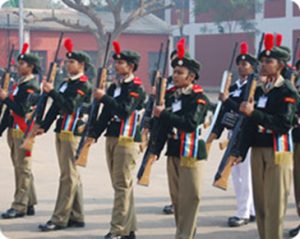 The ‘Aims’ of the NCC laid out in 1988 have stood the test of time and continue to meet the requirements expected of it in the current socio–economic scenario of the country. The NCC aims at developing character, comradeship, discipline, a secular outlook, the spirit of adventure and ideals of selfless service amongst young citizens. Further, it aims at creating a pool of organized, trained and motivated youth with leadership qualities in all walks of life, who will serve the Nation regardless of which career they choose. Needless to say, the NCC also provides an environment conducive to motivating young Indians to join the armed forces.
The ‘Aims’ of the NCC laid out in 1988 have stood the test of time and continue to meet the requirements expected of it in the current socio–economic scenario of the country. The NCC aims at developing character, comradeship, discipline, a secular outlook, the spirit of adventure and ideals of selfless service amongst young citizens. Further, it aims at creating a pool of organized, trained and motivated youth with leadership qualities in all walks of life, who will serve the Nation regardless of which career they choose. Needless to say, the NCC also provides an environment conducive to motivating young Indians to join the armed forces.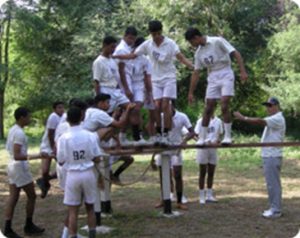
To Create a Human Resource of Organized, Trained and Motivated Youth, To Provide Leadership in all Walks of life and be Always Available for the Service of the Nation.
To Provide a Suitable Environment to Motivate the Youth to Take Up a Career in the Armed Forces.
To Develop Character, Comradeship, Discipline, Leadership, Secular Outlook, Spirit of Adventure, and Ideals of Selfless Service amongst the Youth of the Country.
Inauguration of NCC
The schools and colleges opened after summer vacation and the NCC of Independent India was inaugurated on 15 Jul 1948. The journey of this Indian youth organization, which has now become the largest uniformed youth organization in the world had begun.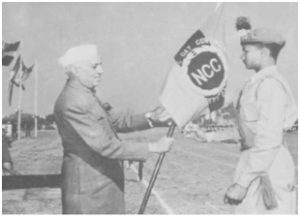
In the year 1948 a total of 96 units of Senior Division were raised, comprising variety of units to include one Armored Corps, three Artillery, five Engineers, two Signals and two Medical – and 83 companies of Infantry. As there was some delay in the establishment of NCC in UP, Madras and Bihar, whose Govts wanted every student joining NCC to be verified by police prior to enrolment, only 20,000 cadets had joined the NCC in the year 1948. The raising of the Junior Division units did not progress well owing to shortage of trained school teachers. The main difficulty was that adequate number of teachers of the desired quality did not come forward to work as NCC officers. There were various administrative reasons attributed to this. Sometimes, colleges and schools were not in a position to spare the teaching staff except during the summer vacation. Thus, the NCC which has now13 lakh cadets on its rolls, had started with 20,000 cadets in 1948.
First Prime Minister of India Jawaharlal Nehru reviewing Guard of Honor
Pandit Jawaharlal Nehru presenting Republic Day banner
Motto Of NCC
The need for having motto for the Corps was discussed in the 11th Central Advisory Committee (CAC) meeting held on 11 Aug 1978. The mottos suggested were “Duty and Discipline”; “Duty, Unity and Discipline”; “Duty and Unity”; “Unity and Discipline”. The final decision for selection of “Unity and Discipline” as motto for the NCC was taken in the 12th CAC meeting held on 12 Oct 1980.
Core Values
The NCC is a responsive, learning and continuously evolving organization. Its activity is guided by certain core values that we endeavor to instill among all ranks of the NCC. These include the following:
- A sense of patriotic commitment to encourage cadets to contribute to national development.
- Respect for diversities in religion, language, culture, ethnicity, life style and habitat to instill a sense of National unity and social cohesion.
- Abiding commitment to learn and adhere to the norms and values enshrined in the Indian Constitution.
- Understanding the value of a just and impartial exercise of authority.
- Ability to participate in community development and other social programmed.
- A healthy life style free of substance abuse and other unhealthy practices.
- Sensitivity to the needs of poor and socially disadvantaged fellow citizens.
- Inculcating habits of restraint and self-awareness.
- Understanding the values of honesty, truthfulness, self-sacrifice, perseverance and hard work.
- Respect for knowledge, wisdom and the power of ideas.
PLEDGE
WE THE CADET OF THE NATIONAL CADET CORPS,
DO SOLOEMNLY PLEDGE THAT WE SHALL ALWAYS UPHOLD THE UNITY OF INDIA.
WE RESOLVE TO BE DISCIPLINED AND RESPONSIBLE CITIZEN OF OUR NATION.
WE SHALL UNDERTAKE POSITIVE COMMUNITY SERVICE IN THE SPIRIT OF SELFLESSNESS
AND CONCERN FOR OUR FELLOW BEINGS.
NCC Flag
The NCC flag for various units of the NCC was first introduced in 1951. The flag was of same pattern, color and size as was used by various regiments of the Army. The only difference was that it had the NCC badge and unit designation placed in the center. Later on, it was felt that the flag should be in keeping with the inter-service character of the Corps. In 1954 the existing tricolor flag was introduced. The three colors in the flag depict the three services of the Corps, red for the Army, deep blue for the Navy and light blue for the Air Force. The letters NCC and the NCC crest in gold in the middle of the flag encircled by a wreath of lotus, give the flag a colorful look and a distinct identity.
National Service Scheme, under the Ministry of Youth Affairs & Sports Govt. of India, popularly known as NSS was launched in Gandhiji’s Birth Centenary Year 1969, in 37 Universities involving 40,000 students with primary focus on the development of personality of students through community service. Today, NSS has more than 3.2 million student volunteers on its roll spread over 298 Universities and 42 (+2) Senior Secondary Councils and Directorate of Vocational Education all over the country. From its inception, more than 3.75 crores students from Universities, Colleges and Institutions of higher learning have benefited from the NSS activities, as student volunteers.
The main objectives of National Service Scheme (NSS) are:
- Understand the community in which they work
- Understand themselves in relation to their community
- Identify the needs and problems of the community and involve them in problem-solving
- Develop among themselves a sense of social and civic responsibility
- Utilize their knowledge in finding practical solutions to individual and community problems
- Develop competence required for group-living and sharing of responsibilities
- Gain skills in mobilizing community participation
- Acquire leadership qualities and democratic attitudes
- Develop capacity to meet emergencies and natural disasters and
- Practice national integration and social harmony
Motto
The Motto of NSS “Not Me but You”, reflects the essence of democratic living and upholds the need for self-less service. NSS helps the students develop appreciation to other person’s point of view and also show consideration to ‘/other living beings. The philosophy of the NSS is well doctrine in this motto, which underlines/on the belief that the welfare. of an individual is ultimately dependent on the welfare of the society on the whole and therefore, the NSS volunteers shall strive for the well-being of the society.
COVERAGE:
Under NSS our college has organized very successful and result oriented field programmed. Currently there are 2 units running in the institute with 100 volunteers each. Every year one village is adopted where the development work is done by the NSS volunteers. Throughout the year some or other work is done for the welfare of the villagers and to convey the knowledge about their rights and duties. “JAN JAGRUKTA” rally’s, blood donation camps, plantation, shramdan, free medical check-ups, plantation are some activities done by volunteers all-round the year. In the process, the college students also learn to shoulder their responsibility towards their nation.
PROPOSED YEAR CALENDER:
MONTH | PROGRAMME |
JULY |
|
AUGUST |
|
SEPTEMBER |
|
OCTOBER |
|
NOVEMBER |
|
DECEMBER |
|
JANUARY and FEBRUARY |
|
MARCH and APRIL |
|
MAY and JUNE |
|
The Bharat Scouts & Guides is a registered Organization under Societies Registration Act of XXI 1860 with headquarters in New Delhi. State Association is affiliated to the National Association.
Scout/Guide movement has been active in Rajasthan since the second decade of the twentieth century in colonial period well established various units in Jaipur, Jodhpur, Udaipur, Bikaner, Bharatpur, Alwar and Ajmer started functioning into the State Association.
With the merger of the Bharat Scouts & Guides on 7the Nov. 1950. All the units in the state were also merged regulating the formation of “Rajasthan State Bharat Scouts & Guides” organization.
In the state, one State Headquarters 7 divisional headquarters, 33 district headquarters and 312 local Associations are well running with the units in schools are the grass root level. Elected members of the local and Divisional Associations form the state council, which is the apex body. The council has tenure of 5 years. State council comprise of 1- President, 12 Vice-Presidents and one State Chief Commissioner who are democrat Ely elected.
First Scout troop become operational in 1912. In Rajasthan and the units continued to grow gradually. At the time of merger in 1950, the census of the Rajasthan State Association in scout section was 28862 and in guide section 2882 total 31744.
The Organization has grown quantitatively and qualitatively and the Rajasthan State Association is a pioneer state in the map of the country.
We believe in nurturing well-rounded individuals who are prepared for success in all aspects of life. Our Skills and Development program focuses on equipping students with the tools, mindset, and abilities they need to thrive academically, socially, and personally.
- Academic Excellence and Critical Thinking
- Problem-Solving Skills: Through interactive lessons, project-based learning, and inquiry-driven activities, students develop strong problem-solving abilities, learning to think critically and approach challenges with innovative solutions.
- Research and Analytical Skills: Encouraging independent research, data analysis, and the evaluation of sources fosters critical thinking, preparing students for higher education and the workforce.
- Time Management: Our curriculum and extracurricular activities promote the development of effective time management, helping students balance academics with personal commitments.
- Leadership and Teamwork
- Leadership Development: Our school encourages students to take leadership roles in both academic and extracurricular settings. From student council to team captains and class monitors, students gain invaluable experience in leading peers, making decisions, and taking initiative.
- Collaboration and Teamwork: We emphasize the importance of working collaboratively in a team, whether in group projects, sports, or social initiatives. This fosters cooperation, communication, and respect for different perspectives.
- Communication and Public Speaking
- Presentation Skills: Through regular opportunities such as class presentations, debates, and talent shows, students develop their public speaking skills, learning how to convey ideas confidently and persuasively.
- Effective Writing: Our writing programs focus on clear and concise communication, enabling students to express their thoughts effectively, whether through essays, creative writing, or reports.
- Digital Literacy and Technology Skills
- Technology Integration: Students are exposed to a variety of digital tools and resources in their learning, including online research platforms, coding, and interactive learning environments, ensuring they are equipped to navigate the digital world confidently.
- Coding and STEM: Through coding workshops, robotics clubs, and STEM-focused initiatives, students build technical skills that are increasingly valuable in today’s technology-driven world.
- Personal and Social Development
- Emotional Intelligence: Through SEL (Social and Emotional Learning) programs, students learn to manage their emotions, understand others, and build strong relationships, which contributes to their overall personal growth.
- Conflict Resolution: Students are taught strategies for resolving conflicts peacefully and respectfully, fostering a positive, supportive environment within the school community.
- Growth Mindset: Our approach emphasizes resilience and a growth mindset, encouraging students to view challenges as opportunities for development rather than obstacles.
- Career Readiness
- Workplace Skills: We offer career exploration activities, internships, and mentorship programs that help students develop practical skills such as interview techniques, professional communication, and workplace etiquette.
- College and Career Counseling: Our dedicated counselors assist students in exploring potential career paths, preparing for college admissions, and setting long-term professional goals.
- Financial Literacy: Programs that cover basic financial principles—such as budgeting, saving, and investing—are introduced, helping students make informed financial decisions as they transition into adulthood.
- Creativity and Innovation
- Art, Music, and Drama: Through a rich variety of creative programs, including art classes, music ensembles, and drama productions, students explore their artistic talents and develop their creative expression.
- Innovative Thinking: Encouraged to think outside the box, students engage in innovative projects and hands-on learning that allow them to apply their ideas in real-world scenarios.
- Global Citizenship and Responsibility
- Cultural Awareness: Students participate in cultural exchange programs, international projects, and global awareness activities that help them understand and appreciate diversity.
- Environmental Stewardship: Our school instills a sense of responsibility for the environment, with initiatives focused on sustainability, recycling, and eco-friendly practices.
Support for Student Growth
We provide a comprehensive support system to guide each student through their personal and academic journey, including:
- Individualized Learning Plans: Tailored strategies for students who need extra support or are seeking advanced challenges.
- Counseling Services: Mental health support and counseling services to help students navigate personal challenges and build emotional resilience.
- Extracurricular Opportunities: A wide range of clubs, sports, and activities that foster growth beyond the classroom, from debate teams to coding clubs to environmental groups.
RSCIT (Rajasthan State Certificate in Information Technology)
we are committed to providing students with the skills and certifications they need to excel in the modern, technology-driven world. One such program is the RSCIT (Rajasthan State Certificate in Information Technology), which equips students with essential IT knowledge and skills recognized by the Government of Rajasthan.
What is RSCIT?
The Rajasthan State Certificate in Information Technology (RSCIT) is a foundational course designed to teach students basic computer skills and knowledge of information technology. It is an IT certification provided by the Vardhman Mahavir Open University, Kota under the guidance of the Government of Rajasthan.
The RSCIT program focuses on building computer literacy among students and is particularly beneficial for those interested in developing a strong understanding of digital tools, internet applications, and the use of technology in everyday life.
Why Choose RSCIT at?
- Certified Program
RSCIT is a government-recognized certification, ensuring that students receive a credible qualification that can enhance their resumes and open up various career opportunities. - Comprehensive Curriculum
The RSCIT course covers a broad spectrum of IT topics, including:- Basic Computer Operations
- MS Office (Word, Excel, PowerPoint)
- Internet and Email Usage
- Digital Literacy
- Cyber Security
- File Management and Storage
- Skill Development for Future Careers
In today’s world, computer literacy is essential for almost every profession. The RSCIT program prepares students with fundamental skills that can be applied to various fields, from business and education to technology and entrepreneurship. - Flexible Learning
RSCIT is designed to be accessible to students of all levels, even those with little prior knowledge of computers. The course material is engaging and hands-on, allowing students to practice skills in real-time.
Course Details
- Eligibility:
The RSCIT course is open to students from the age of 14 years and above, and it can be taken alongside regular school studies. - Duration:
The program is typically 3-6 months long, with a mix of classroom instruction and practical sessions. - Certification Exam:
At the end of the course, students must pass an examination conducted by Vardhman Mahavir Open University (VMOU). Upon successful completion, students receive the official RSCIT certification.
Key Skills Gained Through RSCIT
- Basic Computer Skills
Students will gain a comprehensive understanding of how to operate a computer, use software applications, and navigate the internet confidently. - MS Office Proficiency
The program covers the use of essential MS Office applications like Word, Excel, and PowerPoint. These skills are indispensable for academic success and future workplace requirements. - Digital Communication
Students will learn how to use email, video conferencing tools, and social media platforms, enabling effective communication in the digital world. - Internet and Online Services
Knowledge of online resources, e-governance, online banking, and e-commerce platforms will prepare students for the digital economy. - Cyber Security Awareness
The course emphasizes the importance of online safety and security, teaching students how to protect themselves from digital threats like viruses and phishing.
How RSCIT Benefits Students
- Enhances Academic Performance
Students gain the technical skills necessary for online research, assignments, and project work, making their academic journey smoother and more efficient. - Improves Employability
In a competitive job market, having IT skills can set students apart from their peers. RSCIT certification helps students increase their employability in various sectors that require computer proficiency. - Prepares for Future Careers
With digital literacy becoming essential in nearly every profession, RSCIT provides a solid foundation for students pursuing careers in fields such as information technology, business, healthcare, and more. - Boosts Confidence
The hands-on training and practical experience gained during the course empower students, making them more confident in using computers and technology for daily tasks.
How to Enroll in the RSCIT Course
- Registration Process
- Visit the school’s RSCIT registration page or the school office to fill out an enrollment form.
- Provide necessary documents such as proof of age and previous academic records.
- Course Fee
The course fee includes training, materials, and exam costs. Please contact the school’s administrative office for detailed fee structure and payment options. - Class Timings
The RSCIT classes are scheduled at convenient times, ensuring students can balance this course with their school activities. - Classroom and Online Options
In response to evolving learning needs, we offer both in-person and online sessions to make learning more accessible to all students.
By offering the RSCIT course, ensures that its students are well-equipped with the fundamental computer skills needed in today’s digital world. This program is a great way to enhance students’ learning experience and help them gain the confidence and qualifications required for future academic and professional success.
This content structure presents a thorough overview of the RSCIT course while also emphasizing the benefits it brings to students in terms of both practical skills and future career prospects.
